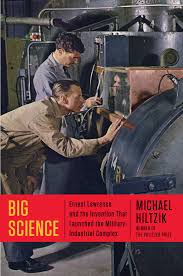Big Science: Ernest Lawrence and the Invention that Launched the Military-Industrial Complex
- By Michael Hiltzik
- Simon & Schuster
- 528 pp.
- Reviewed by Gary Bishop
- September 1, 2015
How a visionary changed the modern world — for better or worse.

Paradoxically, the discipline of “big science” is focused on the infinitesimally small: namely, the application of vast resources by teams of experts to unlock the subatomic universe. Similarly, in his histo-drama, Big Science: Ernest Lawrence and the Invention that Launched the Military-Industrial Complex, author Michael Hiltzik reveals that the accurate grasp of historical events is locked in the minute details from which they evolve and achieve significance.
This book ably illustrates the massive efforts and apparatuses required to understand and control the basic composition of existence: the atom and all its many diversified and quirky subatomic elements. Hiltzik takes us by the hand and, with the deft reporting of a Pulitzer Prize-winning journalist, leads us through the irreversible journey that marked the dawn of the Nuclear Age.
As we approach the second half of the 21st century’s second decade, we might wonder why a book about events occurring in the first half of the 20th century should concern us. It’s evident in the reading of Big Science that Hiltzik harbored those concerns, too, and he takes great pains to connect Ernest Lawrence’s achievements to current events.
He reminds us that the science of physics was the playground of geniuses like Lawrence, Robert Oppenheimer, Werner Heisenberg, and others who achieved international celebrity status as the public breathlessly watched and applauded the unlocking of atomic secrets.
Indeed, Lawrence would grace the cover of Time Magazine in November 1937 with the caption, “He Creates and Destroys,” a notion that proved prophetic given the central role he would play when the world sank into the nervous state of Assured Mutual Destruction that marked the Cold War era.
Hiltzik reports that Lawrence was rather impervious to — and chose to be ignorant of — being anointed with Creator-like powers. Lawrence was simply driven to achieve, to aid his country, and determined to show that American physicists could stand shoulder to shoulder with their European counterparts.
In this manner, Lawrence emerges as the quintessential 20th-century American; indeed, his entire short lifetime (he would die in 1958, at age 57, from incurable ulcerative colitis) would take place in that century.
Born into modest conditions in southeastern South Dakota, Ernest Orlando Lawrence would rise to win the 1939 Nobel Prize for Science as father of the Cyclotron, a machine able to split nuclei and create artificial elements. The Cyclotron would become the core device that allowed America to win the Arms Race, as well as to isolate biological isotopes for use in medicine.
The impact of Lawrence’s Cyclotron wouldn’t be limited to nuclear physics, or even medical breakthroughs, however. In 2012, its derivative cousin, the Large Hadron Accelerator, would be used to discover the Higgs boson. This discovery is significant in the validation of the Big Bang Theory as chronicled in Sean Carroll’s The Particle at the End of the Universe.
Hiltzik’s book, together with Carroll’s and Lee Smolin’s The Trouble with Physics, forms a sort of trilogy for the layman interested in understanding the impact of physics on modern-day science, politics, and daily life. Unlike Carroll and Smolin, who are both Ph.D. physicists, Hiltzik employs a journalist’s talents for making this enigmatic and pedantic science understandable. Importantly, the people — Lawrence in particular — take center stage in Big Science, as Hiltzik brings them to life and illuminates their personalities, idiosyncrasies, triumphs, and failures.
Still, this strength also proves to be a weak point in Hiltzik’s ability to understand and convey Lawrence’s genius. Lawrence’s command of nuclear physics is never quite presented. There are no equations, no direct quotes from his voluminous published research from the University of California Berkeley, to help us understand the brainpower he possessed.
Instead, Hiltzik presents Lawrence as an engineer and inventor, an organizer, a cheerleader of sorts, a manipulator of graduate-student talent, and as a fund-raiser and promoter. While these attributes certainly were a part of Lawrence’s abilities, none would be as remarkable if he hadn’t mastered such intellectual concepts as quantum mechanics and nuclear fission.
Ultimately, we get a picture of the scientist as a preppy type-A overachiever able to recognize the opportunities extant in being in the right place at the right time. This does not resonate as inaccurate; rather, it feels incomplete.
When asked why this book now, Hiltzik explained, “I found that the achievements and risks embodied in big science for nuclear physics created by Lawrence still exist today in the form of the Genome Project and other large-scale scientific endeavors. We must understand the ramifications of nation-sponsored science and its impact on society, politics, and daily lives.”
The portrait of Lawrence as the puppet-master and integrator of science, politics, industry, and military might is fully realized in Big Science. For anyone participating in these complex disciplines, the book is an enlightening read about how one 20th-century genius pulled off far-reaching accomplishments.
The narrative delivers a detailed blueprint of the level of talent, energy, and oft-ruthless people-skills required to overcome mountains of obstacles in the path of momentous scientific discovery. Hiltzik makes resonant the infinite details that comprise the paradox of the infinitesimal and the big science required to unmask it.
Gary Bishop holds a B.S. in physics and mathematics from Northern Arizona University and an MBA from Pepperdine University. His short stories have appeared in the Pisgah Review and the Los Angeles Library Literary Awards. His historical novel about Californios and the early settlements in California comes out in 2016. Follow him on Twitter at @garybishop.

_80_121.png)